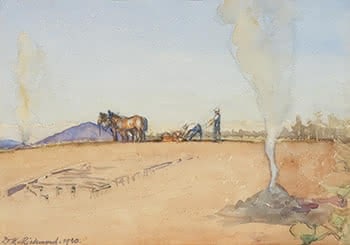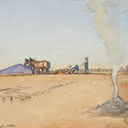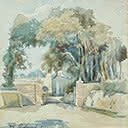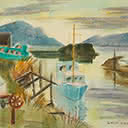Ploughing the Land
24 x 34 cm
est. $1,500 - 2,500
Dorothy Kate Richmond was born in Parnell, Auckland, to James Crowe Richmond and Mary Smith. Her father was a talented watercolourist and Dorothy followed his lead, training at the Slade School of Fine Art, London, 1878-80. On her return to Nelson in late 1880, Richmond was one of a small group of New Zealand-born women to have received a professional training in art.
She became a member of the New Zealand Academy of Fine Arts in 1890, relocating to Wellington in 1894 with her father where she studied under James Nairn in 1896.
Richmond's father was a close friend and painting companion of William Mathew Hodgkins and in the summer of 1898 she decided to leave New Zealand for Europe with the intention of meeting up with Frances Hodgkins. Richmond was a pivotal force in Hodgkins' life during this period, introducing her to Irish painter Norman Garstin, whose advice, support and friendship she greatly valued.
Both artists joined Garstin's 1901 summer school at Caudebec and later travelled together to Britain, France, Italy and the Netherlands. Richmond and Hodgkins returned to New Zealand in 1903 and rented a studio in Bowen Street, Wellington, where they taught private pupils.
In 1904 they mounted an exhibition of 80 of their European paintings at McGregor Wright Gallery in Lambton Quay. When Hodgkins returned to Europe in early 1906, Richmond kept both the Bowen Street studio and the private pupils.
Richmond became a prominent member of the New Zealand Academy of Fine Arts as a teacher and also exhibiting nationally. In this last role she influenced many other artists including Owen Merton. Richmond was greatly admired as a teacher and she continued exhibiting in Wellington, Auckland and Christchurch until 1934.
At Wellington's annual art exhibition in 1928, her works drew the comment that "one of her watercolours among a thousand would be instantly recognised for the subtle beauty of its colour, often suggestive of the interior of pearl shell, and her sure, free and fluent drawing" (Evening Post). Her apparently effortless renditions of the New Zealand landscape, nearly always in watercolour, show how attractive Naturalism could be, even as Modernism was claiming the headlines.





